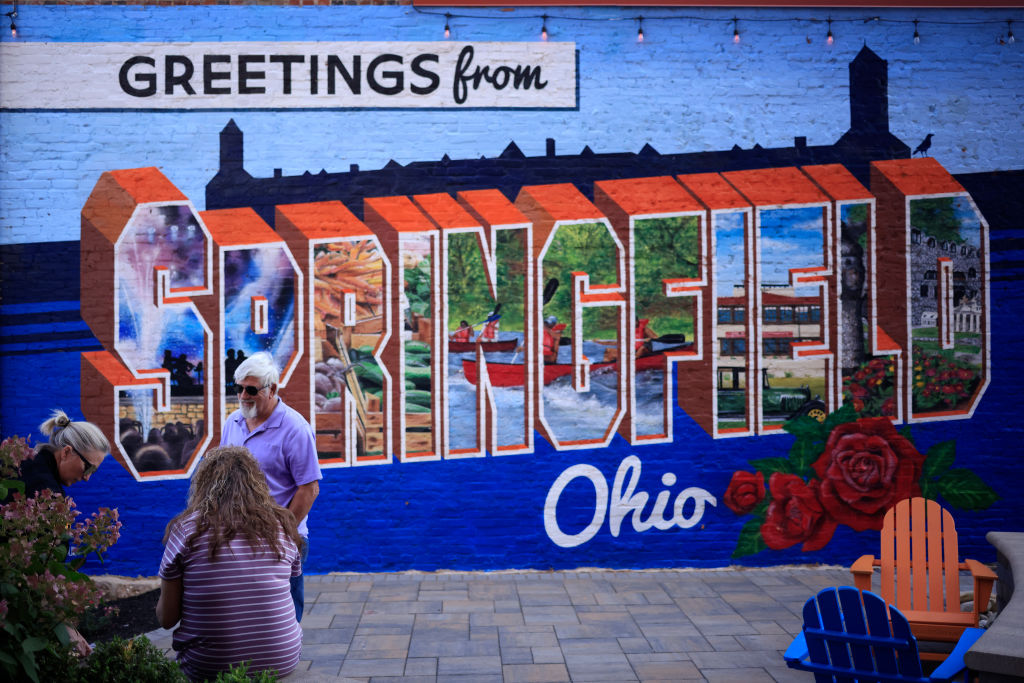
Happening in Springfield: New immigrants offer economic promise, health system challenges
By Stephanie Armour, KFF Health News
When Republican vice presidential candidate JD Vance claimed Haitian immigrants had caused infectious-disease rates to “skyrocket” in Springfield, Ohio, local health commissioner Chris Cook checked the records.
They showed that in 2023, for example, there were four active tuberculosis cases in Clark County, which includes Springfield, up from three in 2022. HIV cases had risen, but sexually transmitted illnesses overall were decreasing.
“I wouldn’t call it skyrocketing,” said Cook, noting that there were 190 active cases in 2023 in all of Ohio. “You hear the rhetoric. But as a whole, reportable infectious diseases to the health department are decreasing.”
Tensions are running high in this industrial town of about 58,000 people. Bomb threats closed schools and public buildings after GOP presidential nominee Donald Trump falsely claimed that Haitian immigrants — who he alleged were there illegally — were stealing and eating household pets. City and county officials disputed the claims the former president levied during his Sept. 10 debate with Vice President Kamala Harris, his Democratic opponent.
A U.S. flag is displayed on September 16, 2024 in Springfield, Ohio. Springfield, home to a large Haitian community, was thrust into the national spotlight after former President Donald Trump made claims during the presidential debate against Vice President Kamala Harris, accusing members of the immigrant community of eating the pets of local residents. The claims, which have since been called into question, have been circulating online and in the news media, and in the days following the debate local institutions faced multiple bomb threats. (Photo by Luke Sharrett/Getty Images)
Trump was amplifying comments made by Vance that — along with his claims about the immigration status of this population — were broadly panned as false. When asked during a CNN interview about the debunked pet-eating rumor, Vance, a U.S. senator from Ohio, acknowledged that the image he created was based not on facts but on “firsthand accounts from my constituents.” He said he was willing “to create” stories to focus attention on how immigration can overrun communities.
But Ohio Gov. Mike DeWine, also a Republican, has said immigrants have been an economic boon to Springfield. Many began arriving because businesses in the town, which had seen its population decrease, needed labor.
Largely lost in the political rancor is the way Springfield and the surrounding area responded to the influx of Haitian immigrants. Local health institutions tried to address the needs of this new population, which had lacked basic public health care such as immunization and often didn’t understand the U.S. health system.
The town is a microcosm of how immigration is reshaping communities throughout the United States. In the Springfield area, Catholic charities, other philanthropies, volunteers, and county agencies have banded together over the past three to four years to tackle the challenge and connect immigrants who have critical health needs with providers and care.
For instance, a community health center added Haitian Creole interpreters. The county health department opened a refugee health testing clinic to provide immunizations and basic health screenings, operating on such a shoestring budget that it’s open only two days a week.
And a coalition of groups to aid the Haitian community was created about two years ago to identify and respond to immigrant community needs. The group meets once a month with about 55 or 60 participants. On Sept. 18, about a week after Trump ramped up the furor at the debate, a record 138 participants joined in.
“We have all learned the necessity of collaboration,” said Casey Rollins, director of Springfield’s St. Vincent de Paul, a nonprofit Catholic social services organization that has become a lifeline for many of the town’s Haitian immigrants. “There’s a lot of medical need. Many of the people have high blood pressure, or they frequently have diabetes.”
Several factors have led Haitians to leave their Caribbean country for the United States, including a devastating earthquake in 2010, political unrest after the 2021 assassination of Haiti’s president, and ongoing gang violence. Even when health facilities in the country are open, it can be too treacherous for Haitians to travel for treatment.
“The gangs typically leave us alone, but it’s not a guarantee,” said Paul Glover, who helps oversee the St. Vincent’s Center for children with disabilities in Haiti. “We had a 3,000-square-foot clinic. It was destroyed. So was the X-ray machine. People have been putting off health care.”
An estimated 12,000 to 15,000 Haitian immigrants live in Clark County, officials said. About 700,000 Haitian immigrants lived in the United States in 2022, according to U.S. Census data.
Those who have settled in the Springfield area are generally in the country legally under a federal program that lets noncitizens temporarily enter and stay in the United States under certain circumstances, such as for urgent humanitarian reasons, according to city officials.
The influx of immigrants created a learning curve for hospitals and primary care providers in Springfield, as well as for the newcomers themselves. In Haiti, people often go directly to a hospital to receive care for all sorts of maladies, and county officials and advocacy groups said many of the immigrants were unfamiliar with the U.S. system of seeing primary care doctors first or making appointments for treatment.
Many sought care at Rocking Horse Community Health Center, a nonprofit, federally qualified health center that provides mental health, primary, and preventive care to people regardless of their insurance status or ability to pay. Federally qualified health centers serve medically underserved areas and populations.
The center treated 410 patients from Haiti in 2022, up more than 250% from 115 in 2021, according to Nettie Carter-Smith, the center’s director of community relations. Because the patients required interpreters, visits often stretched twice as long.
Rocking Horse hired patient navigators fluent in Haitian Creole, one of the two official languages of Haiti. Its roving purple bus provides on-site health screenings, vaccinations, and management of chronic conditions. And this school year, it’s operating a $2 million health clinic at Springfield High.
Many Haitians in Springfield have reported threats since Trump and Vance made their town a focus of the campaign. Community organizations were unable to identify any immigrants willing to be interviewed for this story.
Hospitals have also felt the impact. Mercy Health’s Springfield Regional Medical Center also saw a rapid influx of patients, spokesperson Jennifer Robinson said, with high utilization of emergency, primary care, and women’s health services.
This year, hospitals also have seen several readmissions for newborns struggling to thrive as some new mothers have trouble breastfeeding or getting supplemental formula, county officials said. One reason: New Haitian immigrants must wait six to eight weeks to get into a program that provides supplemental food for low-income pregnant, breastfeeding, or non-breastfeeding postpartum women, as well as for children and infants.
Related Articles
Will an influx of Californians into Arizona tilt the battleground state’s politics?
Biden administration races to shell out billions for clean energy as election nears
Millions lose power every year because of extreme weather. Here’s how we could prevent it
Wealthier Americans are driving retail spending and powering US economy
Olympic snowboarder,15 others accused of drug trafficking operation, 4 murders
At Kettering Health Springfield, Haitian immigrants come to the emergency department for nonemergency care. Nurses are working on two related projects, one focusing on cultural awareness for staff and another exploring ways to improve communication with Haitian immigrants during discharge and in scheduling follow-up appointments.
Many of the immigrants are able to get health insurance. Haitian entrants generally qualify for Medicaid, the state-federal program for the low-income and disabled. For hospitals, that means lower reimbursement rates than with traditional insurance.
During 2023, 60,494 people in Clark County were enrolled in Medicaid, about 25% of whom were Black, according to state data. That’s up from 50,112 in 2017, when 17% of the enrollees were Black. That increase coincides with the rise of the Haitian population.
In September, DeWine pledged $2.5 million to help health centers and the county health department meet the Haitian and broader community’s needs. The Republican governor has pushed back on the recent national focus on the town, saying the spread of false rumors has been hurtful for the community.
Ken Gordon, a spokesperson for the Ohio Department of Health, acknowledged the difficulties Springfield’s health systems have faced and said the department is monitoring to avert potential outbreaks of measles, whooping cough, and even polio.
People diagnosed with HIV in the county increased from 142 residents in 2018 to 178 to 2022, according to state health department data. Cook, the Clark County health commissioner, said the data lags by about 1.5 years.
But Cook said, “as a whole, all reportable infections to the health department are not increasing.” Last year, he said, no one died of tuberculosis. “But 42 people died of COVID.”
Healthbeat is a nonprofit newsroom covering public health published by Civic News Company and KFF Health News. Sign up for its newsletters here.
KFF Health News is a national newsroom that produces in-depth journalism about health issues and is one of the core operating programs of KFF — the independent source for health policy research, polling and journalism.
©2024 KFF Health News. Distributed by Tribune Content Agency, LLC.


